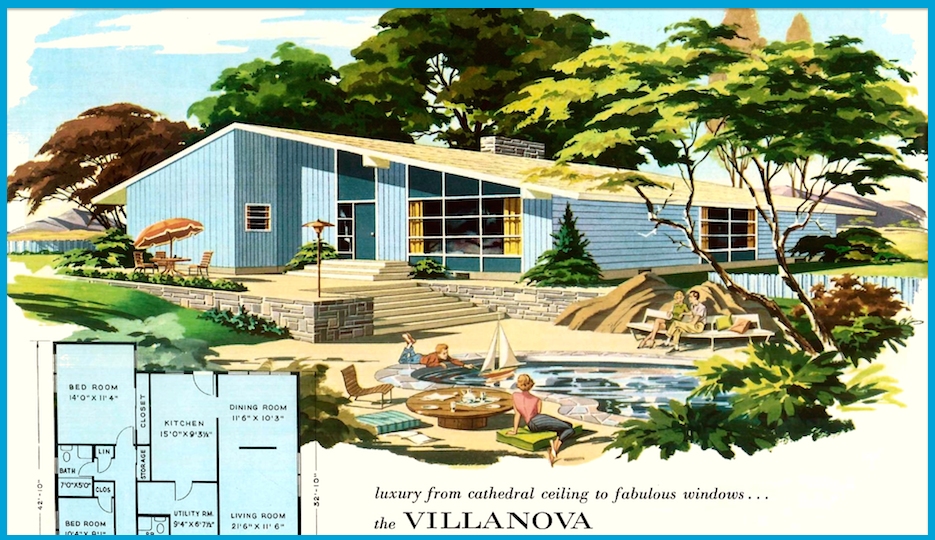Philadelphia Metro Has 27 of 1,000 Richest U.S. Neighborhoods

Image from a home builders catalog via Flickr user MidCentArc.
The Higley 1,000 — the list of America’s 1,000 wealthiest neighborhoods — has just been released by by geographer Stephen Higley. For those of us on the East Coast, there aren’t too many surprises: We can shrug our collective shoulders at the news that New York and Connecticut are full of moneyed white people. But it’s interesting to see the results for the Philadelphia metro area.
First, let’s listen to Higley talk about how tough it is to define “neighborhood”:
The concept of “neighborhood” in America is to say the least, amorphous. Realtors are notorious at “stretching” ill-defined neighborhood boundaries of wealthy places in the interest of generating higher prices through a halo effect.
Mapping companies vary from identifying virtually every sub-division (ADC Maps) to the grudging vagueness of a few well known neighborhoods (eg. Thomas Brothers Guides, Rand McNally). Google Maps, my main source for updating the Higley 1000 for 2010, has done an excellent job of adding neighborhoods in recent years. Still, there are many areas that are difficult to name as a “neighborhood”. I have used a variety of resources in trying to identify individual neighborhoods including extensive use of the internet.
(That’s cute — “extensive use of the internet.” Well, yes, we all use that thing from time to time.)
At any rate, Higley primarily relies on Census tracts (roughly 2,000 households), which are divided into Block Groups (about 500 households). For the 2010 Census, there are 216,279 Block Groups; Higley isolated the roughly 3,000 with mean household incomes of $200,000 and above.
All incorporated or unincorporated places with a mean household income of over $240,000 are on the list. Smaller places (with over 400 residents) were added to the list geographically intact. Larger places, such as central cities or large affluent suburbs (such as Bethesda or Lake Forest) were broken up into neighborhoods.
Below, the results for the Philadelphia metro area, which includes parts of New Jersey and Delaware.
1: Alapocas (New Castle Cty, DE)
2: Villanova East (Lower Merion Twp)
3: Bryn Mawr East (Lower Merion Twp)
4: Washington Crossing (Solebury Twp)
5: Gladwyne (Lower Merion Twp)
6: Ardmore South (Ardmore)
7: Moorestown East (Moorestown Twp)
8: Upper Makefield Township North (Upper Makefield Twp)
9: Winterthur-Centreville (New Castle Cty, DE)
10: Penn Valley (Lower Merion Twp)
11: Waterloo (Easttown Twp)
12: Southern Willistown Township-White Manor CC (Willistown Twp)
13: Welsh Valley-Hagys Ford (Lower Merion Twp)
14: Wilderness Acres-Short Hills (Springdale)
15: Ardmore East (Ardmore)
16: Haverford East (Lower Merion Twp)
17: Laurel Creek Country Club-East Moorestown (Moorestown Twp)
18: Easttown South (Easttown Twp)
19: Rosemont (Lower Merion Twp)
20: Lower Makefield Township Northwest (Lower Makefield Twp)
21: Woodside Northwest (Lower Makefield Twp)
22: Waynesborough Country Club (Tredyffrin Twp)
23: Haverford West-Merion Golf Course (Haverford Twp)
24: Thompson Mill-Dutchess Farm Estates (Upper Makefield Twp)
25: Newtown Square-Aronimink Golf Course (Newtown Square)
26: Greenville (Greenville, DE)
27: Meadowbrook (Abington Twp)
One especially interesting real estate-related note from Higley:
Nothing lowers mean household income of a Block Group faster than the presence of rental apartments. Surprisingly, condominiums also appear to cause a dramatic decline in mean household income. Could it be that when considering condominiums, there is also a retirement factor influencing income?
• America’s 1,000 Richest Neighborhoods [The Atlantic Cities]
• All Higley 1000 Neighborhoods by Metropolitan Area [higley1000.com]


